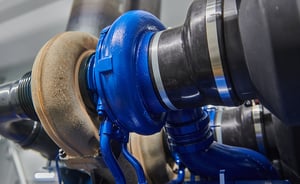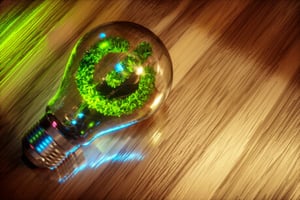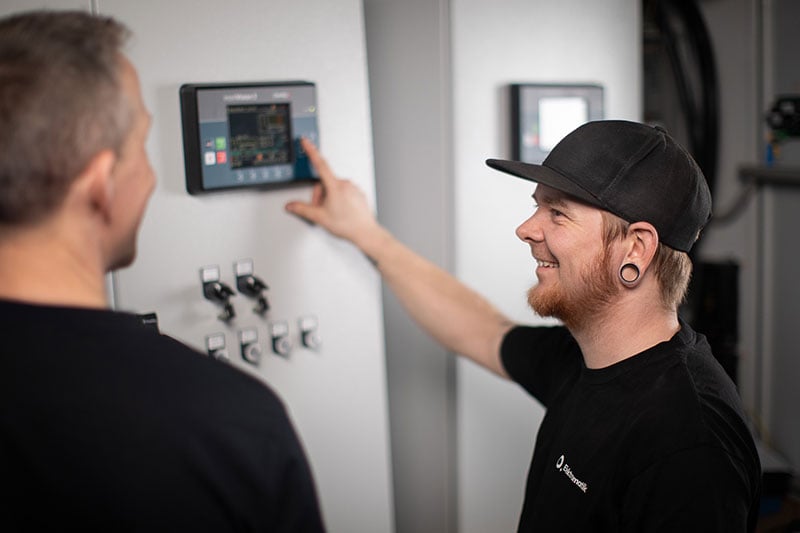
Secure the Uptime of Your Power System 24/7/365
Reliable Power Systems for Uninterrupted Operations
Ensuring maximum uptime for your power system is critical to your business operations. With our comprehensive range of services, you can minimize disruptions in your operations and keep your equipment running smoothly.
Throughout the entire lifecycle of your system, you can count on our Nordic team of specially trained service technicians to take responsibility, so you can focus on your core business.
Benefits:
- Improved reliability
- Reduced maintenance costs
- Increased productivity
- Optimised performance


_web.jpg?width=300&name=Control-system-(2)_web.jpg)


In Need of Support?
We are here to help you. If you have a service agreement, you have access to our support 24/7.
Service Agreements
You can choose from a selection of standard or tailor-made service agreements for your installations within the scope of supply. Our agreements are based on ideal maintenance plans for your system and can be adapted to suit your specific needs.
Highly skilled technicians perform processing and renovation of engine components from smaller repairs to complete component refurbishment.
Benefits:
- Low response time
- Secured uptime of your system
- Increased availability of your system
- Swift and easy access to spare parts
As a part of a service agreement, you can also choose a support agreement which ensures that our experienced service technicians will support you in case of failure or breakdown of your system.
A support agreement can include both remote and on-site support 24/7/365 and is based on specific service levels, such as response time, that meet your requirements. With an extensive network of service technicians in the Nordics, we are always available to help you.
In the event of power outages or emergencies, our skilled field service technicians provide on-site service and maintenance for your power systems to ensure their optimal functioning and availability.
We offer various essential services including:
-
System upgrades: If your system requires an upgrade or is not performing efficiently, we may recommend upgrades to improve its performance or increase its capacity
-
Emergency response, diagnosis and repair: In the case of a power outage or other emergencies, our field service engineers will respond quickly to your site, diagnose the issue and restore your system as soon as possible
-
Training and advice: We provide training on how to operate and maintain your systems, as well as offer advice on the best practices to keep your systems in excellent working condition
Access to Critical Components Made Easy
Fast access to spare parts is vital to keep your system up and running. Our warehouses across the Nordics and quick market access allow us to provide standard parts within hours and special parts within days.
As a distributor of mtu, our stock is online with mtu’s global network of spare parts and can normally be shipped within one day.
You have the option to either purchase spare parts in advance or sign up for a service agreement. If you have a service agreement, we handle the spare parts and deliver them to you within an agreed response time.
Benefits:
- Increased uptime and availability of your system
- Reduced risk of costly disruptions
- Reduced complexity and costs in your supply chain
- Specialised technical support
Control Equipment
In many countries today the grid utility has a high reliability and a lot of the generating sets that are installed as backup power has few running hours, even if the complete generating set is old. The engine and the generator, if taken care of properly, probably has quite a few years left but the control equipment can feel as if they are out of date and it may even be hard to find spare parts.
To update all of your equipment may be a hefty investement, especially when most of the equipment are still working as it should. Hence, we often see that the end users asks for an update of the control system and by that extending the lifetime of the complete backup power solution.
Elektromatik can help you as a customer with both standardized or customized solutions as an alternative for an update of the control equipment for you backup power. Our personnel is specialized on many of todays common control equipment solutions and we are standby to help you update your control equipment.

Environmental Service
Environmental Service of Your Emergency Power Systems
Our primary focus on sustainable environmental service is the extension of the lifespan of your emergency power system through upgrades and modernizations, based on detailed analysis and with a proactive approach to maintenance.
Extend Lifespan & Improve Environmental Performance
Regular preventive maintenance is crucial for ensuring the reliability and longevity of your system, while also minimizing long-term costs. With our specialized environmental service, you can enhance the performance and sustainability of your emergency power systems.
By selecting our environmental service, you safeguard the efficient and sustainable operation of your power system.
Your key benefits:
- Reduced Emissions: Our service helps significantly reduce emissions from your power systems by up to 40%, contributing to a cleaner environment.
- Extended Lifespan of Your System: Through regular maintenance and targeted upgrades, we extend the operational lifespan of your generator installations by up to 50%, providing long-term reliability.
- Increased Reliability: Our comprehensive analysis and preventive maintenance ensure that your system is reliable and performs optimally when you need it most, reducing unexpected failures by up to 30%.
- Improved Operational Efficiency: Upgrades and modernizations based on our environmental service recommendations can enhance the overall efficiency of your power systems by up to 20%.
You benefit from our systematic approach, ensuring top-notch environmental service for your emergency power systems:
- Initial Assessment: We conduct an initial assessment of your power system to understand its current state and identify potential areas for improvement.
- Detailed Analysis: Our experts perform a detailed analysis of the system, examining all critical components and their performance.
- Environmental Report: Based on our analysis, we prepare a comprehensive environmental report that includes upgrade recommendations and modernization plans.
- Implementation of Upgrades: We work closely with you to implement the recommended upgrades, ensuring minimal disruption to your operations.
- Ongoing Maintenance and Monitoring: After the upgrades, we continue to provide regular maintenance and monitoring services to ensure your system remains efficient and environmentally friendly.
Proactive maintenance through our environmental service offers numerous advantages:
- Cost Savings: By identifying and addressing potential issues before they become major problems, you can save significantly on repair and replacement costs, reducing maintenance expenses by up to 25%.
- Compliance with Regulations: Our service ensures that your power systems comply with the latest environmental regulations and standards.
- Enhanced Performance: Regular upgrades and maintenance keep your systems running at peak performance, reducing the risk of unexpected failures.
- Sustainability: Our focus on sustainable practices means that your power systems contribute positively to the environment, aligning with your sustainability goals.
FAQ
In our line of work we get a lot of questions and we are happy to answer them. But as a service for you we have gathered some of the most frequently asked questions that we get and we’ll give you the answers below. If you still haven’t found the answer to your question, don’t hesitate to call us.
PRP – Prime Power is defined according to ISO8528-1 as the maximum power output that a generator set can produce continuously when connected to a variable load for an unlimited number of hours a year if the maintenance intervals and procedures are being carried out as prescribed by the manufacturer. A prime-rated generator set is limited to a 24-hour average load factor of 70%, if not stated otherwise by the manufacturer.
LTP – Limited Time Power is defined according to ISO8528-1 as the maximum power output that a generator set can produce for up to 500 hours a year if the maintenance intervals and procedures are being carried out as prescribed by the manufacturer.
ESP – Emergency Standby Power is defined according to ISO8528-1 as the maximum power output that a generator set can produce when connected to a variable load for a maximum of 200 hours a year if the maintenance intervals and procedures are being carried out as prescribed by the manufacturer. An ESP-rated generator set is limited to a 24-hour average load factor of 70%, if not stated otherwise by the manufacturer.
COP – Continuous Power is defined according to ISO8528-1 as the base load power output that a generator set can produce at a constant load for an unlimited number of hours a year, if the maintenance intervals and procedures are being carried out as prescribed by the manufacturer.
According to legislation within the EU, all generator sets that are subject to movement at least once a year and are below 560kW of mechanical power output from the engine must fulfill the demands in EU Stage V emission requirements. If the generator set isn’t subject to movement, all stationary gensets as an example, the generator set doesn’t have to comply with EU Stage V.
The most used fuel in Sweden for backup power is environmental diesel HVO100. If you are to use any other type of diesel fuel for your backup power, please be careful and check with the vendor if that fuel type is approved, you may experience power deterioration and/or shortened service interval.
As a rule of thumb, a generator set uses 0.25 liters an hour and electrical kW produced.
When discussing the fuel system that you as a customer want to be installed with your backup power the first thing to consider is the running hours that you require, without the need for refueling.
If you have a small generator set and/or a low number of running hours needed, it is normally sufficient to install a day fuel tank within the room/container. If you have a larger generator set and/or require a high amount of running hours, we recommend installing a day fuel tank and an external fuel storage tank. The generator set is connected to the day fuel tank, which is filled from the external fuel storage tank. Filling of the day fuel tank is handled by a fuel transfer pump system. Our fuel transfer pump system is fitted with dual pumps and a control system making the system redundant.
Normally all our fuel tanks are installed with a spill tray or dual-walled.
The generator set requires larger openings for ventilation and combustion air than expected. A generator set with a direct-driven fan and radiator mounted to the base frame has been fitted with a fan big enough to produce enough cooling air both for the engine cooling and the ventilation of the heat rejection to the room.
The amount of air the fan pushes over the radiator plus the amount of combustion air the engine needs is the total amount of air that you must transport into the room/container over the air inlet openings.
Generally, when calculating the needed openings, we calculate using a maximum speed over the inlet grills and louvers set to 4 meters a second. By not exceeding this airspeed you will prevent snow, water and dust to be sucked into the room/container. You also must remember to adjust your numbers according to the grill's flow-dampering specifications. Normal grills reduce the free opening by 35% and a sound-proofed grill reduces the opening by 75%.
The outlet air opening is normally the same size as the radiator. The outlet air can have a higher air speed thus giving the advantage of smaller openings. But it always is necessary to calculate the back pressure over the fan. If you have a back pressure higher than approved by the vendor, you might experience a reduction in power output from the generator set.
When using coolant coolers with your generator set, the aspiration of the engine is important to have in mind. If you have a water-cooled aspiration you only have to fit that cooling circuit with a coolant cooler, but if you have an air-cooled aspiration you most likely will need to install a heat exchanger. A heat exchanger might be needed if the distance and/or the lifting height is too big to handle for the engine's internal water pump.
If you are using coolant coolers the heat rejection to the room still needs to be ventilated from the room and the engine still needs combustion air. The air inlet openings will be significantly smaller and the air outlet opening normally is small and fitted with a frequency-adjusted fan.
How often and how to test your generator set depends on the type of solution you have and which test function you have at your disposal. Some of the test functions will affect your daily operation and that might limit your opportunities to test your backup power.
The start test is the simplest test to perform. If you perform a start test the generator set will start but it will not control any breakers or connect the generator set to the load/grid. This test will make sure your generator set will start if needed and it checks the most common source of a failure, the batteries. Since you are not loading the generator set these tests should only be performed once a week and max. for a couple of minutes.
Load take-over is a test where the generator set starts and, if fitted with synchronization, will synchronize to the grid and disconnect the incoming feeder from the grid. The generator set is now feeding the load. This test will test all involved components, such as the generator breaker and the mains breaker, and since the generator set is loaded it will reach normal running temperature. Hence, everything will be tested, and your daily operations will most likely not be affected.
In parallel with the grid is almost the same as a load takeover, but instead of disconnecting the incoming feeder, the generator set stays in parallel mode. At this point, you can adjust the power output from the generator set. If the generator set produces more power than the load consumes the excess power will be fed out to the grid. Be sure to inform the grid owner that you will perform the test as you need approval from the grid owner.
Simulated mains failure is the best test to perform, if you can allow a short blackout on the load. The test is initiated from the control system, just like all the other tests, and it will simulate an error on the incoming mains. The generator set will start up, disconnect the incoming feeder from the grid and connect to the load. The complete chain of events will be exactly as an actual mains failure.
If you use the tests mentioned above and you perform your tests according to the recommended test interval instructions delivered with our solutions, you can be confident that your system will work when needed.
The control system is the brain of your backup power system. In automatic mode, the control system will perform as expected in case of a mains failure and in manual mode you can control the chain of events. Today most control systems are based on a standard control panel from a vendor that has built and tested the panels to work as intended. The only thing we must do is to adjust it to fit the customer's needs and requirements.
When creating a control system, it's important for the end user to clearly state what type of solution they require and which functions and tests they need. For instance, do they need automatic mains failure start? Is it necessary to synchronize to the grid? Should the system communicate with a BMS (Building Management System)?
Talk to Our Specialists
Terms & Conditions
Do you need information about our terms and sales conditions for our products and solutions?Not What You Needed Help With?
Did this page not answer your questions?